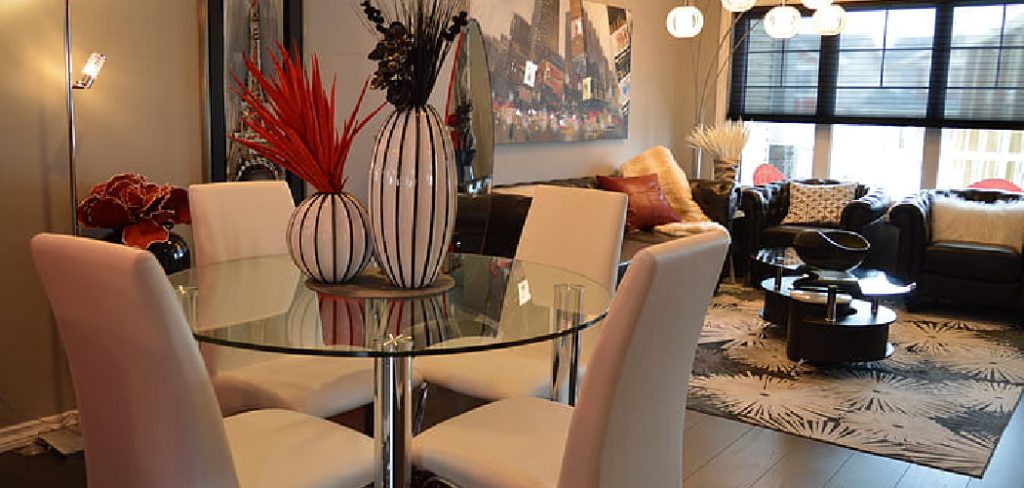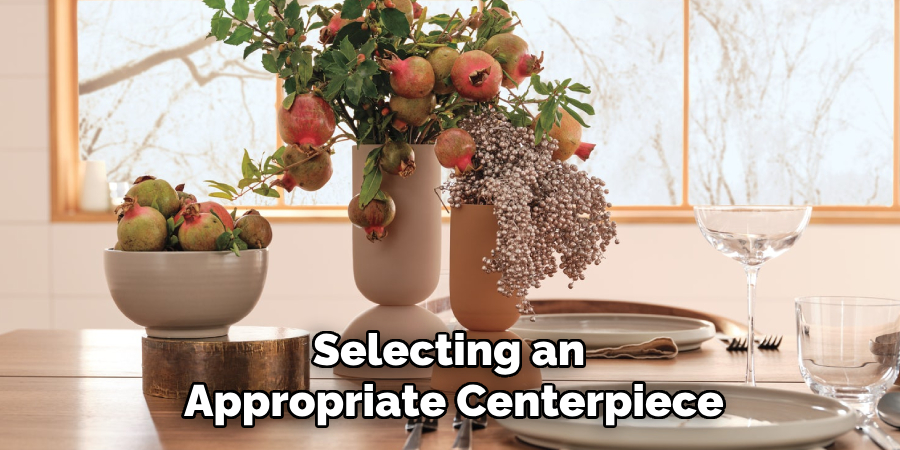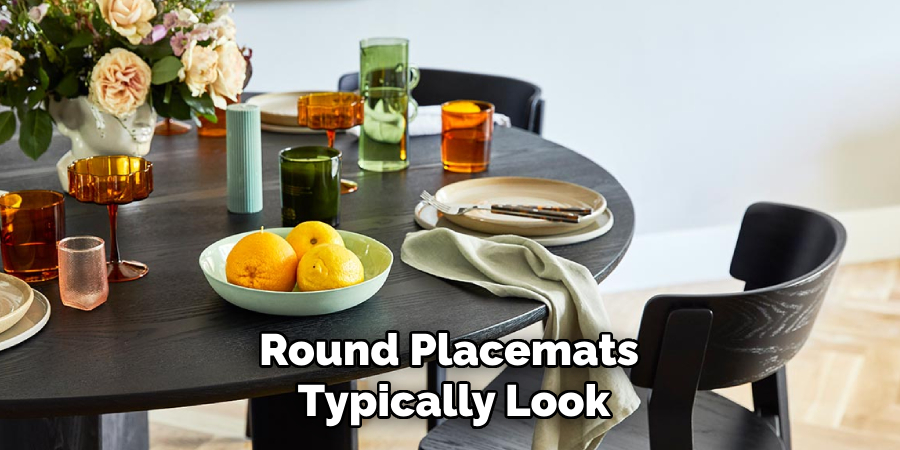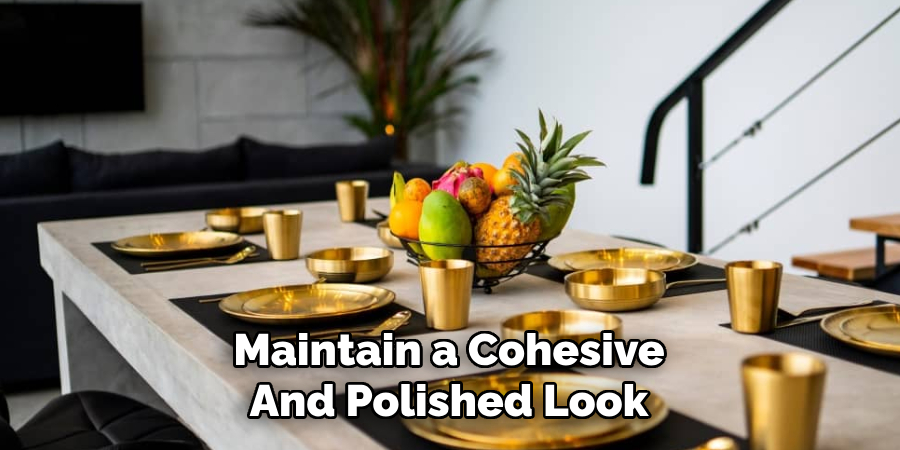A round kitchen table is a versatile and inviting piece of furniture that can be both functional and stylish. Its shape promotes conversation, fosters connection, and makes it easier to fit into small or awkwardly shaped spaces.

However, decorating a round kitchen table can be a bit tricky because it requires balance and attention to scale. This guide will help you discover how to decorate round kitchen table, whether you’re aiming for a casual, everyday look or a formal table setting for special occasions.
We’ll cover essential tips for choosing centerpieces, coordinating tableware, using decorative accents, and more, all while considering your table’s unique shape and design. With the right approach, you can transform your round kitchen table into a stylish focal point in your kitchen or dining area.
Choosing the Right Centerpiece
When it comes to decorating a round kitchen table, the centerpiece plays a pivotal role in defining the overall aesthetic. Selecting the right centerpiece requires careful consideration of scale and proportion to ensure it complements, rather than overwhelms, the table.
Scale and Proportion:
The size of the centerpiece is crucial when decorating a round table. You want something that is proportional to the table’s size but doesn’t dominate the space. For example, if your table is smaller, opt for a low, modest centerpiece, such as a small vase or candle.
For larger round tables, you can go for a more substantial statement piece like a tall flower arrangement or decorative bowl. Ensure the centerpiece is not too large, keep the table accessible for dining, and allow guests to see each other easily across the table.
Fresh Flowers or Greenery:
Fresh flowers or greenery are a classic choice for any table decoration. They can bring life to your space. For a round table, consider using a circular vase or bowl to complement the shape of the table.

Stick to low arrangements if you want an unobstructed view across the table, or use taller, more dramatic arrangements for a formal look. Seasonal flowers or potted plants can add a touch of nature and vibrancy, creating a refreshing and lively atmosphere.
Fruit Bowls or Decorative Bowls:
A decorative fruit bowl can work as a functional and aesthetic centerpiece for a casual, everyday style. Choose a bowl that contrasts with the table’s finish, or opt for one that matches your kitchen’s color palette. Filled with colorful fruits, it adds a splash of color and serves as a practical addition, providing easy access to healthy snacks.
Candles:
For a cozy or romantic atmosphere, consider placing candles in the center of the table. Grouping candles of various heights in a round tray can look elegant while maintaining the balance of the table. You can also opt for a single large candle or a few small tea lights for a softer, minimalist look. Scented candles can further enhance the dining experience by adding an aromatic layer to the ambiance.
Lazy Susan:
A practical yet decorative option is to use a Lazy Susan as a centerpiece. This rotating tray can hold condiments, small plants, or decorative items while also serving a functional purpose during meals. Its movement adds an element of interaction and optimizes space by keeping the center of the table dynamic and easily accessible to everyone seated around it.
In sum, the centerpiece you choose should reflect your style while also honoring the unique character of your round kitchen table. Whether you wish to embrace a minimalist approach or an elaborate design, selecting an appropriate centerpiece can significantly elevate your dining space’s appeal and functionality.

How to Decorate Round Kitchen Table: Using Table Linens
Adding table linens is a great way to enhance the overall aesthetic of your round kitchen table while offering a touch of texture and sophistication.
Tablecloths:
A tablecloth can serve as a base layer to soften the look of your table and tie in your kitchen’s color scheme. When choosing a tablecloth, make sure it fits the round shape properly, hanging evenly on all sides without overwhelming the table.
Light and neutral tones work well for an airy feel, while bold patterns can make a statement. Ensuring the tablecloth complements the existing decor without clashing or overtaking the space is important, allowing for a cohesive and inviting dining table design.
Table Runners:
Though typically used on rectangular tables, a table runner can still be used on a round table if placed horizontally or diagonally. Choose a runner that complements your table’s material and color.
For example, a burlap runner gives a rustic look, while a satin runner adds a touch of elegance. A well-chosen runner can serve as a subtle focal point, adding depth and dimension to your table setting without being too overpowering.
Placemats:
Placemats are a practical and decorative element that can help define each place’s setting. Round or square placemats both work on round tables, but round placemats typically look more harmonious with the table’s shape. Opt for woven, fabric, or bamboo placemats, depending on the style you’re aiming for.
These pieces protect the table surface and allow for individual style expression, adding a personalized touch to the dining experience.

How to Decorate Round Kitchen Table: Coordinating Tableware
Dinnerware:
When setting a round table, your dinnerware should reflect the aesthetic you want to achieve. Simple, neutral plates in white or soft tones can create a clean and elegant appearance for a minimalist look. If you prefer a more colorful or eclectic style, you might consider using bold colors or intricate patterns to express your personality.
Round plates typically complement the shape of the table best, providing a cohesive visual balance. However, don’t hesitate to experiment with square plates for a touch of contrast and a modern flair, as this can add an unexpected twist to your table’s appearance.
Glassware:
Glassware should align with the overall theme of your table setting. Simple glasses or even mason jars can introduce a rustic or casual touch for everyday dining, making the environment feel relaxed and approachable.
On the other hand, for more formal gatherings, opt for crystal or stemmed glasses to elevate the dining experience and add a touch of refinement. The choice of glassware can subtly influence the atmosphere of your meal, lending it either a down-to-earth charm or a sophisticated elegance.
Flatware:
Your choice of flatware should match the style and tone set by your dinnerware. Sleek, modern cutlery complements minimalist table settings, while vintage or ornate pieces may enhance traditional or rustic tablescapes.
To maintain a cohesive and polished look, consider using flatware made from a single material, such as silver, gold, or matte black. This unity in material and design helps tie together the various elements of your table setting, ensuring everything appears well-thought-out and harmoniously integrated.

Napkins and Napkin Rings:
Cloth napkins add a touch of sophistication to a round table setting, offering both visual appeal and functionality. Pair these with decorative napkin rings during special occasions to introduce an extra layer of detail and elegance.
Depending on your design choice, napkin rings can either serve as subtle accents or become standout elements of your table decor. Additionally, get creative by folding napkins into unique shapes or tying them with decorative ribbons—both techniques can personalize your table setup and add an inviting, customized feel for guests.
Seasonal or Occasion-Specific Décor
Holiday Themes
For those special times of the year, seasonal decorating allows your table setting to keep up with the festive spirit. A classic red and green color scheme can instantly bring holiday cheer to your dining area during Christmas.
Consider festive napkins with snowflakes or holly designs, and incorporate holiday-themed centerpieces featuring elements like pine cones, holly leaves, or ornaments. Candles are another effective addition, evoking warmth and coziness while filling the room with inviting scents like cinnamon or pine. You can also make a striking statement by arranging mini Christmas ornaments in a decorative bowl or placing them across the table for a playful touch.
Spring and Summer
With the arrival of spring and summer, it’s time to refresh your table décor with vibrant, fresh colors. Flowers and greenery can bring a lively, airy feel to your dining experience. Opt for pastel-colored tableware to exude subtle elegance, and consider adding a vase filled with seasonal flowers like tulips, daisies, or daffodils.
Light linens in soft shades can complement these accents, maintaining a balance reflecting the warmer months’ rejuvenating essence. The trick is to keep the arrangements light and unfussy, letting nature’s own beauty take center stage.
Autumn
Autumn offers a palette of warm, inviting tones that can transform your dining table into a cozy haven. Embrace colors such as orange, red, and brown through your choice of table linens, placemats, and dinnerware. A centerpiece featuring pumpkins, gourds, or dried flowers can effortlessly infuse a sense of harvest and abundance into your home.
Enhance the rustic charm with a textured table runner made from burlap or linen, complementing the autumn foliage outside. The key is to create an inviting space that mirrors the heartwarming transitions of the fall season.
Formal Occasions
A sophisticated and polished tablescape is crucial for elegant dinners or formal events. Consider bringing height and elegance to the table with a tall floral arrangement paired with candle holders that add a touch of refinement.
Fine china and glassware with intricate designs can offer exclusivity to the occasion, while metallic accents like gold or silver in placemats, napkin rings, or centerpieces add a layer of luxury. This coordinated elegance enhances the formal atmosphere, making the dining experience memorable.
Casual Everyday Style
When it comes to everyday dining, simplicity and practicality are key. A casual table setting doesn’t mean sacrificing charm. A single vase with fresh flowers can brighten your dining space with minimal effort.
Alternatively, a decorative tray housing essentials like salt and pepper shakers, napkins, or a small stack of coasters can be both functional and stylish. Keeping the décor understated ensures the table remains welcoming without feeling cluttered, allowing it to effortlessly transition through daily use.

Conclusion
Decorating a round kitchen table is all about balance and making the most of the table’s unique shape. By carefully selecting the right centerpiece, thoughtful table linens, and coordinated tableware, your round table can transform into a stylish and functional part of your kitchen or dining area.
Whether you’re exploring how to decorate round kitchen table for everyday use, a special occasion, or a seasonal celebration, there are numerous ways to adapt the décor to fit your needs. It’s important to consider the scale of your table, maintain a balance of materials and colors, and ensure the comfort of your guests.
With these decorating tips, your round kitchen table will serve as an inviting gathering space and a beautiful focal point in your home.
Professional Focus
Angela Ervin, a former interior designer turned blogger, specializes in kitchen design and renovations. Through her website, she blends her passion for cooking with design expertise, sharing practical and creative ideas. Known for balancing functionality and beauty, Angela’s insightful content has made her a trusted voice in home design and lifestyle.
About the Author
Angela Ervin, an experienced interior designer and blogger, combines her passion for kitchen renovations with storytelling. Living in Petersburg with her family, she enjoys cooking and testing her projects firsthand. Known for her humor and relatable style, Angela shares creative, functional design insights through her content, making her a trusted voice in home design.
Education History
University: Virginia Commonwealth University
Degree: Bachelor of Fine Arts (BFA) in Interior Design
- Angela’s education at VCU focused on mastering core interior design principles, including spatial planning, color theory, materials selection, and sustainable design practices.
- She gained hands-on experience through studio projects and collaborative design exercises, which honed her ability to create functional and aesthetically pleasing environments.
- Her coursework also emphasized problem-solving and practical applications of design, preparing her for real-world projects like her self-directed kitchen renovations.
- The program’s strong foundation in both technical skills and creative expression shaped Angela’s ability to seamlessly integrate form and function in her work.


